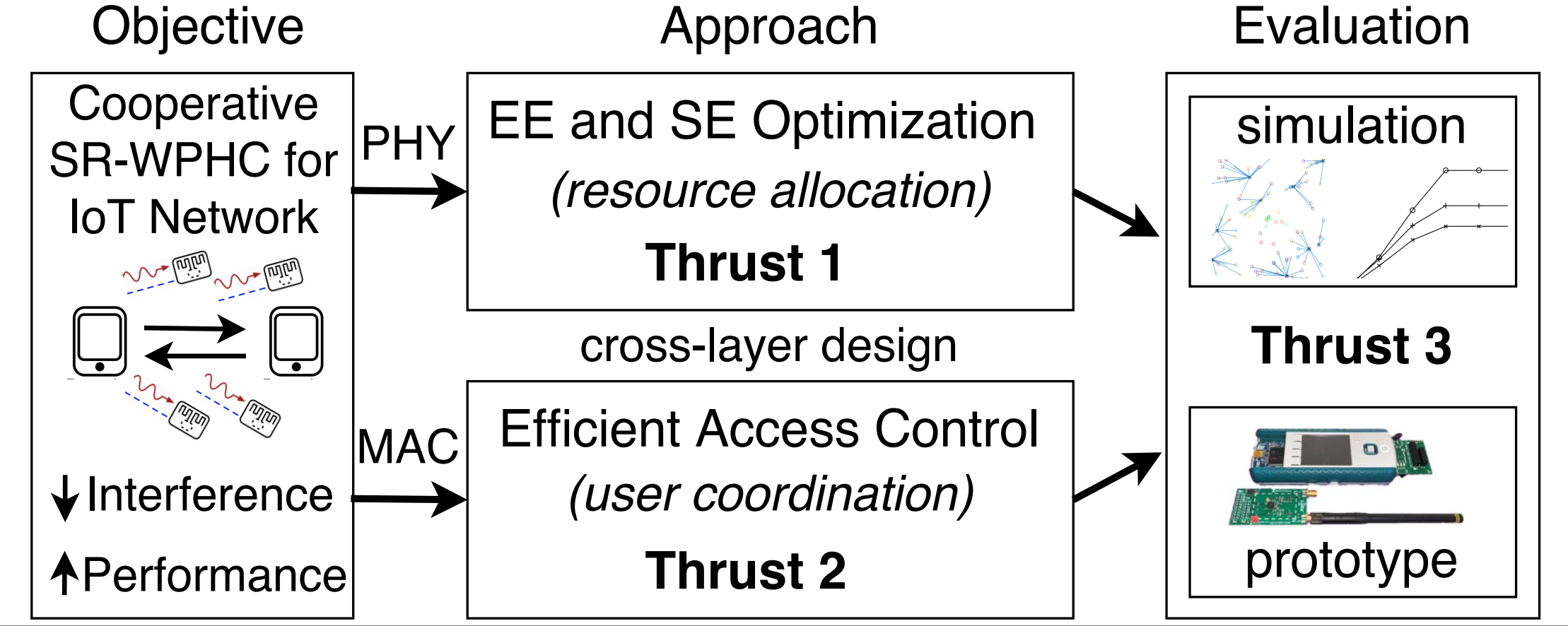CRII:CNS: Towards Spectrum and Energy Efficient Large-scale IoT Communications: A Cross-layer Optimization Approach
List of Personnel
Principle Investigator
Haijian Sun, Assistant Professor
Students
Paul Kudyba (Graduate Student)
Xiaona Gao (co-advised by Dr. Yinghui Ye)
Sterling Strohauer (Undergraduate Student)
Project Description
Recent years have witnessed the increasing proliferation of Internet of Things (IoT) devices, fueled by wide applications on healthcare, entertainment, monitoring, and smart homes. Enabling ubiquitous connectivity, massive traffic, and sustainable deployment of IoT demand for higher spectrum and energy efficiency (SE and EE). Existing approaches such as active communication (LoRA, Sigfox, etc) and passive ambient backscatter communication (AmBC) cannot meet those requirements. In particular, AmBC is widely considered as the solution to simultaneously address both spectrum and energy scarcity challenges. However, its inherit spectrum sharing mechanism limits device density and passive communication alone cannot provide quality of service (QoS).
The objective for this project is to improve both SE and EE performance while providing guaranteed QoS for IoT network at large-scale. Our approach is to enable IoT device with a Wireless Powered Hybrid Communication (WPHC) structure that can not only minimize energy footprint with energy harvesting from ambient signals, but also integrate both passive and active communication to support versatile QoS needs with efficient spectrum utilization through user cooperation. We focus on a cross-layer design with both physical (PHY) and medium access control (MAC) layer for SE and EE optimization. Software and hardware testbed will be developed to evaluate performance of this co-design.
 |
This project starts from 05/2022. So far, the project has resulted the following publications.
Publications
Liqin Shi, Xiaoli Chu, Haijian Sun, and Guangyue Lu. “Wireless Powered OFDMA-MEC Networks with Hybrid Active-Passive Communications”. In: IEEE Internet of Things Journal (2023), pp. 1–1. DOI: 10.1109/JIOT.2023.3241088.
Zhipeng Liu, Yinghui Ye, Xiaoli Chu, and Haijian Sun. “Secrecy Performance of Backscatter Communications With Multiple Self-Powered Tags”. In: IEEE Communications Letters 26.12 (2022), pp. 2875–2879. DOI: 10.1109/LCOMM.2022.3201031.
Xiaona Gao, Yinghui Ye, Guangyue Lu, and Haijian Sun. “Throughput Fairness-Aware Optimization of Cognitive Backscatter Networks with Finite Alphabet Inputs”. In: 2022 IEEECIC International Conference on Communications in China (ICCC). 2022, pp. 463–467. DOI: 10.1109ICCC55456.2022.9880808.
Rui Xu, Liqin Shi, Yinghui Ye, and Haijian Sun. “Relay-Enabled Backscatter Communications: Linear Mapping and Resource Allocation”. In: IEEE Transactions on Vehicular Technology (2023, submitted).
Xiang Ma, Haijian Sun, Rose Qingyang Hu, and Yi Qian. “Approximate Wireless Communication for Federated Learning”. In Proceedings of the 2023 ACM Workshop on Wireless Security and Machine Learning (WiseML ’23), June 1, 2023, Guildford, United Kingdom (to appear).
Broader Impacts and Other Diseemination Activities
Undergraduate student Sterling Strohauer has designed a FM backscatter communication system and presented his design in UGA ECE's first student EXPO.
Graduate student Paul Kudyba has been testing a latest wireless power transfer and active BLE system (from a startup company). He is currently working on data collection, gateway design, and future integration to WPHC.
 |
Award Information
This project is generous supported by National Science Foundation CNS-2236449. Any opinions, findings, and conclusions or recommendations expressed in this material are those of the authors and do not necessarily reflect the views of the foundation. NSF Link:
 |